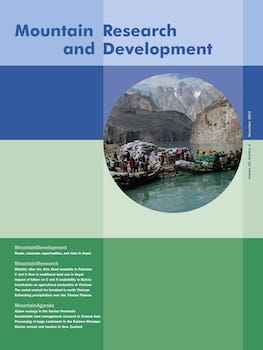High Nature Value Farming in Europe: 35 European Countries—Experiences and Perspectives, edited by Rainer Oppermann, Guy Beaufoy, and Gwyn Jones. Ubstadt-Weiher, Germany: Verlag Regionalkultur, 2012. 544 pp. € 49.80. ISBN 978-3-89735-657-3.
The High Nature Value (HNV) farming concept, established in Europe in the early 1990s, describes those types of farming activity and farmland that, because of their characteristics, can be expected to support high levels of biodiversity or species and habitats of conservation concern. The European Union (EU) and its Member States have committed themselves to supporting and maintaining HNV farming, especially through the Rural Development Programmes, which are part of the Common Agricultural Policy. The dominant characteristic of HNV farming is its low intensity, leading to a high diversity of land cover that may enable significant levels of biodiversity to survive. While HNV farmland covers about 17% of the mountains of the EU, if one excludes the Nordic countries of Finland and Sweden, where there is very little arable or pasture land in the mountains, the proportion is 33% (European Environment Agency 2010).
This book provides an overview of HNV farmland in Europe, including not only EU Member States but also other countries, such as those of Southeastern Europe and Switzerland. It derives particularly from the work of the European Forum on Nature Conservation and Pastoralism (EFNCP), the only European organization focusing on the maintenance of low-intensity livestock farming.
The book starts with 2 brief chapters that introduce the concept of HNV farming, its evolution, differences from other types of agriculture, and importance, as well as possible future changes linked to land ownership, agricultural practices, and part-time farming. Chapter 3 then describes the types of HNV farmland—seminatural vegetation, species-rich arable land, permanent crops, and mosaic landscapes—and concludes with a brief section on farmland as habitat for populations of conservation interest, referring to both individual and groups of species.
Chapter 4 makes up the majority of the book: some 333 pages that provide an illustrated overview of HNV farmland in 35 European countries. Each chapter begins with a summary in the national language(s) and a table that summarizes some key facts about the country: area, population (total and density), land use, and characterization of the agricultural sector. It is noted that, although the latter data are derived from the official EUROSTAT statistics, these are not entirely consistent across countries, so that official figures often underestimate the area of land being farmed. Similarly, the length (4 to 24 pages), structure, and content of the 35 chapters vary considerably—which can be regarded as a reflection of the different types of, and attention given to, HNV farmland across these 35 countries. Each chapter ends with key references.
Chapter 5 is entitled “Reflections on HNV farming—experiences and perspectives.” It contains 9 sections whose themes vary in their breadth. A strong message that comes from these sections is that HNV farmland provides a wide range of public goods and ecosystem services, often more than from intensive agriculture, and that this needs to be recognized in policies that support HNV farming and the people who practice it. HNV farming can be associated with various opportunities for regional development; but farmers need to be informed about such opportunities, and policy-makers of the wider benefits and how they can be enhanced through policy instruments—whose application needs to be monitored. The 9 sections in Chapter 5 provide many examples of all of these issues.
The book concludes with 2 short chapters: “How should EU and national policies support HNV farming?” and “Conclusions—what does the future hold for HNV farming?” The EFNCP has a long history of interaction with the European Commission, so these chapters are very well informed and, one hopes, will influence the forthcoming period of the Common Agricultural Policy (2014–2020) as well as policies in European countries that are not part of the EU, including Turkey, not included in this book, but where the HNV concept is also beginning to take hold. Nevertheless, one key issue that is barely addressed here is the aging of the farming population, which can pose serious challenges to HNV farming, even though much of it is part time. This is often associated with the abandonment of HNV farmland, with significant impacts on biodiversity, particularly important for the 26% of HNV farmland in mountain areas that is included in the EU's Natura network of protected areas (European Environment Agency 2010).
Overall, this book provides an excellent introduction to a great diversity of land uses across Europe's mountains (and beyond) and their great relevance for not only those who depend on them for their livelihoods, but also for those concerned with biodiversity conservation and the delivery of many other ecosystem services. It is beautifully produced, with color photographs, maps, and other figures throughout. The one element that is missing is an index, which, given the diversity of themes, would have been of great benefit. The price is remarkably low, probably a reflection of the financial support given to the production of the book by the European Commission and agencies in a number of countries (all with mountains)—which suggests that they continue to believe that HNV farming is a concept worth supporting.





